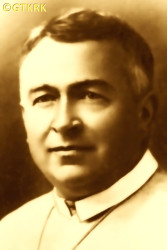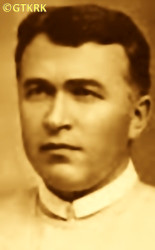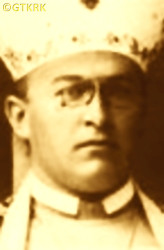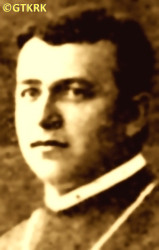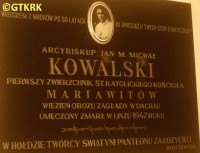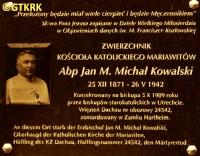Roman Catholic
St Sigismund parish
05-507 Słomczyn
85 Wiślana Str.
Konstancin deanery
Warsaw archdiocese, Poland
full list:
displayClick to display full list

searchClick to search full list by categories
wyświetlKliknij by wyświetlić pełną listę po polsku

szukajKliknij by przeszukać listę wg kategorii po polsku

Martyrology of the clergy — Poland
XX century (1914 – 1989)
personal data
surname
KOWALSKI
forename(s)
John (pl. Jan)
religious forename(s)
Mary Michael (pl. Maria Michał)
function
archbishop
creed
Mariavite Church in Poland (from 1935) MImore on
en.wikipedia.org
[access: 2013.05.19]
academic distinctions
Sacred Theology MA
date and place
of death
18.05.1942

KL Dachau ‐ MunichGermany (Bavaria) ‐ Austria
alt. dates and places
of death
26.05.1942 (KL Dachau „death certificate” date)
details of death
In 1931 sentenced to 2 years in prison for „lewd acts against juvenile women of the convent and for using his position to force prostitution upon subordinate nuns”.
Execution of the sentence was suspended until 09.07.1936.
Jailed in Rawicz prison.
Released on 09.01.1938.
After German and Russian invasion of Poland in 09.1939 and start of the World War II, after start of German occupation, arrested by the Germans on 25.01.1940.
Jailed in Płock prison.
Next on 25.04.1941 transported to KL Dachau concentration camp.
Finally from there — totally exhausted — transported in a so‐called Germ. „Invalidentransport” (Eng. „Invalids' transport”) towards TA Hartheim Euthanasia Center where was to be murdered in a gas chamber.
Did not reach the destination — prob. already in the camp, just before the formation of the Germ. „Invalidentransport” and loading of the victims on the railway siding in KL Dachau onto the freight wagon in which the prisoners were transported, or on the first stage of the journey to the Euthanasia Center TA Hartheim, on the way to Munich, and there thrown out of the wagon and then incinerated in the city crematorium.
According to the death certificate, prepared in KL Dachau, the „honest” otherwise German „medical doctors” and formalists — and at the same time, unrivaled fairy tale spinners — noted that the cause of death was Germ. „Versagen von Herz und Kreislauf, bei Darmkatarrch” (Eng. „Heart and circulatory failure, with intestinal catarrh”).
prisoner camp's numbers
24542Click to display source page (KL DachauClick to display the description)
cause of death
extermination: gassing in a gas chamber
perpetrators
Germans
sites and events
TA HartheimClick to display the description, «Aktion T4»Click to display the description, KL DachauClick to display the description, PłockClick to display the description, «Intelligenzaktion»Click to display the description, Regierungsbezirk ZichenauClick to display the description, Ribbentrop‐MolotovClick to display the description
date and place
of birth
26.12.1871Birth certification on:
skanoteka.genealodzy.pl
[access: 2025.09.08]

Latowicztoday: Latowicz gm., Mińsk Mazowiecki pov., Masovia voiv., Poland
more on
en.wikipedia.org
[access: 2021.12.18]
alt. dates and places
of birth
14.12.1871
(Julian calendar)
parents
KOWALSKI John
🞲 ?, ? — 🕆 ?, ?

SYTEK Catherine
🞲 ?, ? — 🕆 ?, ?
baptism
26.12.1871Birth certification on:
skanoteka.genealodzy.pl
[access: 2025.09.08]

Latowicztoday: Latowicz gm., Mińsk Mazowiecki pov., Masovia voiv., Poland
more on
en.wikipedia.org
[access: 2021.12.18]
St Valentine Priest and Martyr and Holy Trinity RC church
presbyter (holy orders)
ordination
24.04.1897

Warsawtoday: Warsaw city pov., Masovia voiv., Poland
more on
en.wikipedia.org
[access: 2021.10.09]
positions held
from 1935
archbishop — Mariavite Church in Poland (from 1935) — after the split in the Mariavite Church
1921 – 1935
archbishop — Old–Catholic Mariavite Church in Poland (from 1919) — self‐proclaimed (self‐appointment)
05.10.1909
Bishop — Mariavite Church (1909‐1919) — ordination: Utrecht
1906
excommunicated, apostate of the Roman Catholic Church
c. 1906
parish priest — Stara Sobótkatoday: Grabów gm., Łęczyca pov., Łódź voiv., Poland
more on
en.wikipedia.org
[access: 2021.04.22] ⋄ St Matthew the Apostle and St Roch the Confessor RC parish ⋄ Łęczycatoday: Łęczyca urban gm., Łęczyca pov., Łódź voiv., Poland
more on
en.wikipedia.org
[access: 2021.12.18] RC deanery
c. 1904 – c. 1905
parish priest — Niesułkówtoday: Stryków gm., Zgierz pov., Łódź voiv., Poland
more on
en.wikipedia.org
[access: 2021.05.30] ⋄ St Adalbert the Bishop and Martyr RC parish ⋄ Brzezinytoday: Brzeziny urban gm., Brzeziny pov., Łódź voiv., Poland
more on
en.wikipedia.org
[access: 2020.11.27] RC deanery
c. 1903
general minister — Congregation of Mariavite Priests of Perpetual Adoration of Supplication
1903
Provincial — Płocktoday: Płock city pov., Masovia voiv., Poland
more on
en.wikipedia.org
[access: 2021.12.18] ⋄ Congregation of Mariavite Priests of Perpetual Adoration of Supplication
c. 1903
chaplain — Warsawtoday: Warsaw city pov., Masovia voiv., Poland
more on
en.wikipedia.org
[access: 2021.10.09] ⋄ Warsaw Charity Society's Orphanage for Girls at Rakowiecka Str. ⋄ Warsaw‐in‐urbedeanery name
today: Warsaw city pov., Masovia voiv., Poland RC deanery
c. 1900 – c. 1902
vicar — Warsawtoday: Warsaw city pov., Masovia voiv., Poland
more on
en.wikipedia.org
[access: 2021.10.09] ⋄ Transfiguration of the Lord RC parish ⋄ Warsaw‐in‐urbedeanery name
today: Warsaw city pov., Masovia voiv., Poland RC deanery
from 1900
novitiate — Congregation of Mariavite Priests of Perpetual Adoration of Supplication
c. 1899
vicar — Wolatoday: district of Warsaw, Warsaw city pov., Masovia voiv., Poland
more on
en.wikipedia.org
[access: 2021.12.18] ⋄ St Stanislav the Bishop and Martyr and St Lawrence the Deacon and Martyr RC parish ⋄ Warsaw‐extra‐Urbemdeanery name
today: Warsaw city pov., Masovia voiv., Poland RC deanery
c. 1898
vicar — Łódźtoday: Łódź city pov., Łódź voiv., Poland
more on
en.wikipedia.org
[access: 2021.07.18] ⋄ Exaltation of the Holy Cross RC parish ⋄ Łódźtoday: Łódź city pov., Łódź voiv., Poland
more on
en.wikipedia.org
[access: 2021.07.18] RC deanery
c. 1894 – c. 1897
student — Sankt Petersburgtoday: Saint Petersburg city, Russia
more on
en.wikipedia.org
[access: 2020.07.31] ⋄ theology, Imperial Roman Catholic Spiritual Academy (1842‐1918) — postgraduate specialised studies crowned with a Sacred Theology Master's degree
c. 1889 – c. 1893
student — Warsawtoday: Warsaw city pov., Masovia voiv., Poland
more on
en.wikipedia.org
[access: 2021.10.09] ⋄ philosophy and theology, Metropolitan Theological Seminary
author of the translation of the Holy Bible into Polish
married
comments
The urn with ashes — cremation prob. took place in the crematorium at the Germ. Ostfriedhof (Eng. Eastern Cemetery) in Munich — since 1950 has been kept at the Am Perlacher Forst cemetery, in a place known as Germ. Ehrenhain I (Eng. „Remembrance Grove No. 1”), in Munich. In 2013, information about the „disclosure” of the cremated remains of the KL Dachau victims made it to the front pages of news outlets. His urn bears the No. K3655.
others related
in death
KOMARClick to display biography Stanislav, KONIECZNYClick to display biography Julian, KOTLICKIClick to display biography Ignatius, KOTTClick to display biography Valentine, KOWALEWSKIClick to display biography Stanislav, KOWNACKIClick to display biography Martin Stanislav, KOZANECKIClick to display biography Adam, KOŹBIAŁClick to display biography Michael, KRAWCZYŃSKIClick to display biography Roman, KROPLEWSKIClick to display biography Albin John, KRUKOWSKIClick to display biography Joseph, KRUPCZYŃSKIClick to display biography Casimir Stanislav, KUBIŃSKIClick to display biography Stanislav, KUKLAClick to display biography Stanislav, KULIŃSKIClick to display biography Steven, KUTZNERClick to display biography Leo, KWAŚKIEWICZClick to display biography Leo Henry, KWIATKOWSKIClick to display biography Boleslav, LEWANDOWSKIClick to display biography Francis, LUDWICZAKClick to display biography Anthony John, LUDWIKClick to display biography Joseph, LUDWIKIEWICZClick to display biography Steven Ignatius, ŁABENTOWICZClick to display biography Sigismund Peter, ŁASZKIEWICZClick to display biography Stanislav, MAJKOWSKIClick to display biography Hillary, MAKOWSKIClick to display biography Alexander John, MARUSARZClick to display biography Stanislav, MATEUSZCZYKClick to display biography Theodore, MAZALONClick to display biography Benjamin Louis, MICHALEWSKIClick to display biography John Theophilus, MICKIEWICZClick to display biography Leo, MIJAKOWSKIClick to display biography Bogdan Joseph, MOKSClick to display biography Stephen, MOSZCZEŃSKIClick to display biography Stanislav, MREŁAClick to display biography Francis Xavier (Fr Sigismund), MŚCICHOWSKIClick to display biography Anthony, MULLERClick to display biography Joseph Stanislav Kostka, MUSZYŃSKIClick to display biography Sigismund Witold, NAPIERAŁAClick to display biography Francis, NIEDZIELAClick to display biography Joseph, NITECKIClick to display biography Anthony, NOAKClick to display biography Theodore, NOWAKClick to display biography Vincent, NOWICKIClick to display biography Felician, NOWICKIClick to display biography Joseph Henry, OGŁAZAClick to display biography Joseph, OPRZĄDEKClick to display biography John (Bro. Martin), ORYNTClick to display biography Peter, OSIŃSKIClick to display biography Henry, PABICHClick to display biography Stanislav, PACEWSKIClick to display biography Anthony Marian Francis Andrew Michael
sites and events
descriptions
TA Hartheim: From 05.1940, in the Germ. Tötungsanstalt (Eng. Killing/Euthanasia Center) TA Hartheim, at the Schloss Hartheim castle in Alkoven in Upper Austria, belonging to KL Mauthausen‐Gusen complex of concentration camps, as part of «Aktion T4» program, the Germans murdered victims — people mentally retarded and disabled — in gas chambers with carbon monoxide. Till 24.08.1941 and the formal end of the «Aktion T4» program, c. 18,000 people were murdered in TA Hartheim. In 04.1941 the program was extended to include concentration camp prisoners. Most, if not all, of the murdered clergy from the KL Dachau concentration camp were taken to TA Hartheim in the so‐called Germ. „Invalidentransport” (Eng. „transport of invalids”), prisoners who were sick and, according to the Germans, „unable to work” (initially under the pretext of transfer to a better camp) — after the formal end of «Aktion T4» as part of the program codenamed «Aktion 14 f 13». It is estimated that at this stage — until 11.12.1944 — c. 12,000 prisoners were gassed at TA Hartheim.
Note: The dates of death of victims murdered in Schloss Hartheim indicated in the „White Book” are the dates of deportations from the last concentration camp the victims where held in. The real dates of death are unknown — apart from c. 49 priests whose names were included in the niem. „Invalidentransports”, but who did not arrive at TA Hartheim. Prob. perished on the day of transport, somewhere between KL Dachau and Munich, and their bodies were thrown out of the transport and cremated in Munich. The investigation conducted by Polish Institute of National Remembrance IPN concluded, that the other victims were murdered immediately upon arrival in Schloss Hartheim, bodies cremated and the ashes spread over local fields and into Danube river. In order to hide details of the genocide Germans falsified both dates of death (for instance those entered into KL Dachau concentration camp books, which are presented in „White Book” as alternative dates of death) and their causes. (more on: ipn.gov.plClick to attempt to display webpage
[access: 2019.05.30], en.wikipedia.orgClick to attempt to display webpage
[access: 2019.05.30])
«Aktion T4»: German state euthanasia program, systematic murder of people mentally retarded, chronically, mentally and neurologically ill — „elimination of live not worth living” (Germ. „Vernichtung von lebensunwertem Leben”). At a peak, in 1940‐1941, c. 70,000 people were murdered, including patients of psychiatric hospitals in German occupied Poland — German formalists noted then that, among others, „performing disinfection [i.e. gassing] of 70,273 people with a life expectancy of up to 10 years saved food in the amount of 141,775,573.80 Deutschmark”. From 04.1941 also mentally ill and „disabled” (i.e. unable to work) prisoners held in German concentration camps were included in the program — denoted then as «Aktion 14 f 13». C. 20,000 inmates were then murdered, including Polish Catholic priests held in KL Dachau concentration camp, who were murdered in Hartheim gas chambers. The other „regional extension” of «Aktion T4» was «Aktion Brandt» program during which Germans murdered chronically ill patients in order to make space for wounded soldiers. It is estimated that at least 30,000 were murdered in this program. (more on: en.wikipedia.orgClick to attempt to display webpage
[access: 2014.10.31])
KL Dachau: KL Dachau in German Bavaria, set up in 1933, became the main German Germ. Konzentrationslager (Eng. concentration camp) KL for Catholic priests and religious during World War II: On c. 09.11.1940, Reichsführer‐SS Heinrich Himmler, head of the SS, Gestapo and German police, as a result of the Vatican's intervention, decided to transfer all clergymen detained in various concentration camps to KL Dachau camp. The first major transports took place on 08.12.1940. In KL Dachau Germans held approx. 3,000 priests, including 1,800 Poles. The priests were forced to slave labor in the Germ. „Die Plantage” — the largest herb garden in Europe, managed by the genocidal SS, consisting of many greenhouses, laboratory buildings and arable land, where experiments with new natural medicines were conducted — for many hours, without breaks, without protective clothing, no food. They slaved in construction, e.g. of camp's crematorium. In the barracks ruled hunger, freezing cold in the winter and suffocating heat during the summer, especially acute in 1941‐1942. Prisoners suffered from bouts of illnesses, including tuberculosis. Many were victims of murderous „medical experiments” — in 11.1942 c. 20 were given phlegmon injections; in 07.1942 to 05.1944 c. 120 were used by for malaria experiments. More than 750 Polish clerics where murdered by the Germans, some brought to TA Hartheim euthanasia centre set up in Schloss Hartheim in Austria and murdered in gas chambers. At its peak KL Dachau concentration camps’ system had nearly 100 slave labour sub‐camps located throughout southern Germany and Austria. There were c. 32,000 documented deaths at the camp, and thousands perished without a trace. C. 10,000 of the 30,000 inmates were found sick at the time of liberation, on 29.04.1945, by the USA troops… (more on: www.kz-gedenkstaette-dachau.deClick to attempt to display webpage
[access: 2013.08.10], en.wikipedia.orgClick to attempt to display webpage
[access: 2016.05.30])
Płock: In its present location, the prison in Płock was built in 1803 by the Prussians (after the Third Partition of Poland, Płock was initially part of the Prussia). From 1815, it functioned as a Russian prison (among others, the November insurgents were detained there). During World War II, during the German occupation — Płock found itself in the so‐called Germ. Regierungsbezirk Zichenau (Eng. Ciechanów regency), part of the Germ. Provinz Ostpreußen (Eng. East Prussia province) — it was managed by the Germans. The jail ran by the German political police Gestapo was located in a different place — initially in the basement of the present town hall in Płock. From 1941 it was transferred — as an investigative prison — to a building at 1st of May Str., built in 1905. Many of the Polish prisoners were next transported to German concentration camps, mainly KL Soldau, where they perished. After the German defeat, this building was taken over by the Russians, and then by the Polish Commie‐Nazis in the service of the Russian KGB, and treacherous murders of former soldiers of the Polish Clandestine State were prob. carried out there. In 1991, the main prison was visited by Pope St John Paul II, who said to the inmates: „You are condemned, but not doomed”.
«Intelligenzaktion»: German: «Intelligenzaktion» (English: „Intelligence Action”) — a German program of extermination of the Polish elite, mainly the intelligentsia and leadership layers, carried out from the beginning of the occupation in w 09.1939 to 04.1940, mainly in territories directly annexed to Germany, but also in the so‐called Germ. Generalgouvernement (Eng. General Governorate), where it was called «AB‐aktion». In the first phase, immediately after the beginning of the German occupation, during military operations carried out by the Germ. Wehrmacht (Eng. Armed Forces) and the genocidal units of the Germ. Einsatzgruppen (Eng. Operational Groups) of the Germ. Sicherheitspolizei (Eng. Security Police), i.e. SiPo, and Germ. Sicherheitsdienst des Reichsführers SS (Eng. Security Service of the Reichsführer SS), i.e. SD, organized by the Germ. Reichssicherheitshauptamt (Eng. Reich Main Security Office), i.e. RSHA, which followed the troops, carried out under the Germ. Unternehmen „Tannenberg” (Eng. Operation „Tannenberg”) — based on the so‐called Germ. Sonderfahndungsliste (Eng. Special Wanted Lists), i.e. proscription lists of Poles considered particularly dangerous to the Third Reich, prepared by the Zentralstelle II/P (Polen) unit of the German RSHA. Later, implemented by the German civilian occupation authorities and the genocidal unit of the Germ. Volksdeutscher Selbstschutz (Eng. Ethnic Germans Self‐Defense), whose members were Germ. Volksdeutsche (Eng. Ethnic Germans), i.e. representatives of the German minority in Poland. According to various sources, these lists, at the beginning of 09.1939, could have contained the details of 61,000—88,000 „dangerous” Poles — although these figures cannot be confirmed. In total, during this genocide, c. 50,000 teachers, Catholic priests, representatives of the landed gentry, freelancers, social and political activists, and retired military personnel were systematically and methodically murdered. Another 50,000 were sent to concentration camps, where only a negligible percentage survived. (more on: en.wikipedia.orgClick to attempt to display webpage
[access: 2014.10.04])
Regierungsbezirk Zichenau: After the Polish defeat in the 09.1939 campaign, which was the result of the Ribbentrop‐Molotov Pact and constituted the first stage of World War II, and the beginning of German occupation in part of Poland (in the other, eastern part of Poland, the Russian occupation began), the Germans divided the occupied Polish territory into five main regions (and a few smaller). The largest one was transformed into Germ. Generalgouvernement (Eng. General Governorate), intended exclusively for Poles and Jews and constituting part of the so‐called Germ. Großdeutschland (Eng. Greater Germany). From two separate new provinces were created. The two remaining were incorporated into existing German provinces. One of those was the Germ. Regierungsbezirk Zichenau (Eng. Ciechanów regency), created from part of the occupied Warsaw voivodeship, and incorporated into the Germ. Provinz Ostpreußen (Eng. East Prussia) — on the basis of the decree of the German leader Adolf Hitler of 08.10.1939 (formally in force from 26.10.1939) — in which the law of the German state was applicable. The main axis of the policy of the new regency, the territory of which the Germans recognized as the Germ. „Ursprünglich Deutsche” (Eng. „natively German”), despite the fact only 6% of its pre–war Polish part were Germans, was Germ. „Entpolonisierung” (Eng. „Depolonisation”), i.e. forced Germanization, and Germ. Zwangsarbeit (Eng. forced slave labor). Most of the Germ. Zivilarbeiter (Eng. civilian worker) slaved in the Germ. Provinz Ostpreußen. Some Poles— c. 25,000 — were deported to the Germ. Generalgouvernement; some were sent to concentration camps. Children could only learn in German. A policy of terror was pursued against the Polish population — 8 large prisons operated in a small area, Polish organizations and institutions were closed. The Polish press was liquidated. Of the 200 arrested Catholic priests from the Płock diocese, 110 were murdered. Most parishes were left without pastors — only a few priests per county were allowed to serve. Conducting services, sermons and confessions in Polish was prohibited. Churches were plundered and turned into warehouses. Catholic funerals with more than 10 people were prohibited. Crosses, roadside shrines, tombstones and cemeteries were destroyed. After the end of hostilities of World War II, the overseer of this province, the Germ. Reichsstatthalter (Eng. Reich Governor) and the Germ. Gauleiter (Eng. district head) of the German National Socialist Party, Erich Koch, initially went into hiding, then was captured and extradited to the Commie–Nazi republic of Poland prl, sentenced to death, but the sentence was not carried out and died in prison in 1986. The Germ. Regierungspräsidenten Zichenau (Eng. superpresident of the Ciechanów regency) hid better and his post‐war fate is still unknown. (more on: en.wikipedia.orgClick to attempt to display webpage
[access: 2024.06.24])
Ribbentrop‐Molotov: Genocidal Russian‐German alliance pact between Russian leader Joseph Stalin and German leader Adolf Hitler signed on 23.08.1939 in Moscow by respective foreign ministers, Mr. Vyacheslav Molotov for Russia and Joachim von Ribbentrop for Germany. The pact sanctioned and was the direct cause of joint Russian and German invasion of Poland and the outbreak of the World War II in 09.1939. In a political sense, the pact was an attempt to restore the status quo ante before 1914, with one exception, namely the „commercial” exchange of the so‐called „Kingdom of Poland”, which in 1914 was part of the Russian Empire, fore Eastern Galicia (today's western Ukraine), in 1914 belonging to the Austro‐Hungarian Empire. Galicia, including Lviv, was to be taken over by the Russians, the „Kingdom of Poland” — under the name of the General Governorate — Germany. The resultant „war was one of the greatest calamities and dramas of humanity in history, for two atheistic and anti‐Christian ideologies — national and international socialism — rejected God and His fifth Decalogue commandment: Thou shall not kill!” (Abp Stanislav Gądecki, 01.09.2019). The decisions taken — backed up by the betrayal of the formal allies of Poland, France and Germany, which on 12.09.1939, at a joint conference in Abbeville, decided not to provide aid to attacked Poland and not to take military action against Germany (a clear breach of treaty obligations with Poland) — were on 28.09.1939 slightly altered and made more precise when a treaty on „German‐Russian boundaries and friendship” was agreed by the same murderous signatories. One of its findings was establishment of spheres of influence in Central and Eastern Europe and in consequence IV partition of Poland. In one of its secret annexes agreed, that: „the Signatories will not tolerate on its respective territories any Polish propaganda that affects the territory of the other Side. On their respective territories they will suppress all such propaganda and inform each other of the measures taken to accomplish it”. The agreements resulted in a series of meeting between two genocidal organization representing both sides — German Gestapo and Russian NKVD when coordination of efforts to exterminate Polish intelligentsia and Polish leading classes (in Germany called «Intelligenzaktion», in Russia took the form of Katyń massacres) where discussed. Resulted in deaths of hundreds of thousands of Polish intelligentsia, including thousands of priests presented here, and tens of millions of ordinary people,. The results of this Russian‐German pact lasted till 1989 and are still in evidence even today. (more on: en.wikipedia.orgClick to attempt to display webpage
[access: 2015.09.30])
sources
personal:
www.ipgs.usClick to attempt to display webpage
[access: 2012.11.23], pl.wikipedia.orgClick to attempt to display webpage
[access: 2013.10.05], skanoteka.genealodzy.plClick to attempt to display webpage
[access: 2025.09.08], www.ipgs.usClick to attempt to display webpage
[access: 2012.11.23]
bibliographical:
„Urns kept at the Am Perlacher Forst cemetery — analysis”, Mr Gregory Wróbel, curator of the Museum of Independence Traditions in Łódź, private correspondence, 25.05.2020
Fr Matthew Budnik, private correspondence, 21.01.2021
„International Tracing Service (ITS), Bad Arolsen, GermanyClick to display source page”, Arolsen Archives
original images:
commons.wikimedia.orgClick to attempt to display webpage
[access: 2020.05.26], www.ekumenizm.plClick to attempt to display webpage
[access: 2020.05.26], commons.wikimedia.orgClick to attempt to display webpage
[access: 2020.05.26], www.mariawita.plClick to attempt to display webpage
[access: 2020.05.26], commons.wikimedia.orgClick to attempt to display webpage
[access: 2020.05.26], www.ekumenizm.plClick to attempt to display webpage
[access: 2020.10.18]
LETTER to CUSTODIAN/ADMINISTRATOR
If you have an Email client on your communicator/computer — such as Mozilla Thunderbird, Windows Mail or Microsoft Outlook, described at WikipediaPatrz:
en.wikipedia.org, among others — try the link below, please:
LETTER to CUSTODIAN/ADMINISTRATORClick and try to call your own Email client
If however you do not run such a client or the above link is not active please send an email to the Custodian/Administrator using your account — in your customary email/correspondence engine — at the following address:

giving the following as the subject:
MARTYROLOGY: KOWALSKI John
To return to the biography press below:
 Click to return to biography
Click to return to biography








